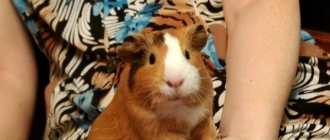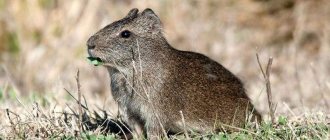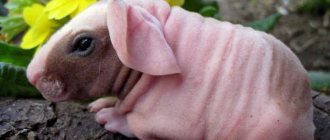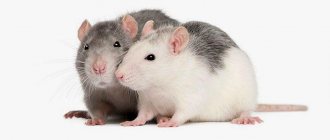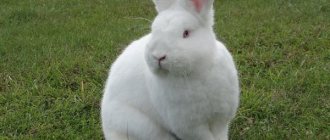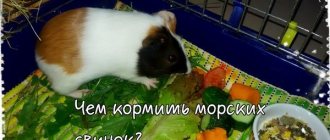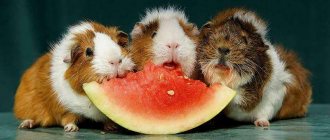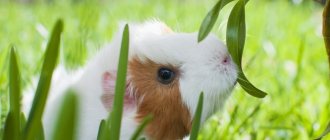- Wild animals
- >>
- Mammals
Agouti (Dasyprocta) or the golden South American hare is a medium-sized animal from the order of rodents. It happens that the animal is called a humpback hare due to its metallic color and fast running, but, despite the name, agouti is more reminiscent of a guinea pig with elongated limbs. The animal swims well and prefers to settle near water bodies. You can learn about other interesting features of the rodent from this publication.
Origin of the species and description
Photo: Agouti
The term "agouti" itself comes from the Spanish: agutí - refers to several species of rodents of the genus Dasyprocta. These animals are native to Middle America, northern and central South America and the southern Lesser Antilles. They are related to guinea pigs and look very similar, but are larger and have longer legs.
Fun Fact: In West Africa (especially Ivory Coast), the name "agouti" refers to the large cane rat, which, as an agricultural pest, is consumed as a delicacy bushmeat.
The Spanish name "agouti" is borrowed from the South American indigenous Tupi-Guarani languages, in which the name is variously written as agutí, agoutí or acutí. The popular Brazilian Portuguese term for these animals, cutia, is derived from this original name. In Mexico, agouti is called sereque. In Panama it is known as eeque and in eastern Ecuador as guatusa.
In total there are 11 species in the genus:
- D. azarae - Agouti Azara;
- D. coibae - Koibansky;
- D. cristata - Crested;
- D. fuliginosa - Black;
- D. guamara - Orinoco;
- D. kalinowskii - Agouti Kalinowski;
- D. leporina - Brazilian;
- D. mexicana - Mexican;
- D. prymnolopha - Black-backed;
- D. punctata - Central American;
- D. ruatanica - Roatan.
Breed classification
Officially, all breeds of guinea pigs are divided into:
- Longhaired,
- Short-haired.
Rosette breed of guinea pigs
However, the types of guinea pigs also have an unofficial classification:
- Rare,
- Popular.
Not only the length and structure of the coat depends on the breed of the animal.
Appearance and features
Photo: Agouti animal
The appearance of the rodent is inimitable - it combines the features of short-eared hares and guinea pigs. The animal's back is rounded (hunchbacked), its head is elongated, its rounded ears are small, short hairless tails are hidden behind long hair and are almost invisible. The animal has bare, round ears, bare feet, wide, horseshoe-shaped nails and 4 molars at the top and bottom.
Video: Agouti
All species vary considerably in color, being brown, reddish, dull orange, grayish or blackish, but usually with paler underparts and sides. Their bodies are covered with coarse, thick hair that stands up when the animal is alarmed. They weigh 2.4–6 kg and are 40.5–76 cm long.
Interesting fact: Agouti's front paws have five toes, but the hind paws have only three toes with hoof-like claws.
Caught in their youth, they are easily tamed, but they are hunted, just like hares. Most species are brown on the back and whitish on the belly. The fur may have a glossy appearance and then shimmer with an orange light. Females have four pairs of ventral mammary glands. Minor changes in appearance may be observed within the same species. Juveniles resemble small adults.
Bald
Now in the world there are only 2 hairless breeds - Baldwin and Skinny pigs.
Skinny
This small fold-eared animal has practically no hair. His bald body is covered with velvety skin, and his muzzle and paws have sparse, modified hair.
The skin of the Canadian Skinny can be colored white, golden, silver, cinnamon or chocolate. Often in the breed there are combined colors, including black and white.
The breed was first introduced in 1976 in Canada. Originally, all skinnies were white with red eyes.
Baldwin
Bald cavey, whose body is covered with soft and very elastic skin. Her skin is warm to the touch and upon tactile contact evokes associations with rubber. The Baldwin guinea pig can be painted in almost any color.
Most often in the breed there are flawless white, pink, black and brown individuals. Also, the bald cavey can have tortoiseshell, Himalayan and Dutch colors.
On a note. The Baldwin guinea pig is born with hairs on its body. After a few days, the animal’s fur gradually begins to fall out. And after a few months, the cavey becomes completely bald.
Where does agouti live?
Photo: Agouti rodent
The animal, Dasyprocta punctata, is commonly known as the Central American agouti and is found from southern Mexico to northern Argentina. The main part of its range extends from the state of Chiapas and the Yucatan Peninsula (southern Mexico) through Central America to northwestern Ecuador, Colombia and far western Venezuela. Highly disjunct populations occur in southeastern Peru, southwestern Brazil, Bolivia, western Paraguay, and extreme northwestern Argentina. Some species have also been introduced elsewhere in the West Indies. Agoutis have also been introduced to Cuba, the Bahamas, Jamaica, Hispaniola and the Cayman Islands.
These rodents live mainly in tropical forests and other wet areas such as swamps. It is rare to find them in the open steppe pampas. They prefer to settle in places with sufficient water. Central American agouti are found in forests, dense thickets, savannas and cultivated areas. In Peru they are limited to the Amazon region, where they are found in all parts of the low rainforest zone and in many parts of the high jungle zone (up to 2000 meters in altitude).
Agoutis are closely associated with water and are often found along the banks of streams, rivers and lakes. They often build dens and numerous sleeping areas in hollow logs, among limestone boulders, or under tree roots or other vegetation. The species is most abundant in Guiana, Brazil and northern Peru.
Now you know where the agouti animal lives. Let's see what he eats.
Ridgeback
Ridgebacks were bred in Sweden in 2004. Their most important external feature is a woolen comb running along the entire length of the back. The color of the hair is varied: from creamy white to ash black. Caring for your pet is incredibly simple: periodically comb out split hairs, introduce vitamin-mineral complexes into the diet during the spring molting period, and visit a veterinarian annually for a routine examination. Ridgebacks are very loyal and sensitive creatures. They do not like to be left alone for a long time, they adore the company of people, and are friendly towards other pets.
Ridgeback
What does agouti eat?
Photo: Agouti in nature
The animals mainly feed on fruits and during their daily excursions they look for fruit-bearing trees. When food is plentiful, they carefully bury the seeds to use as food when fruit becomes scarce. This behavior helps in sowing seeds of many species of forest trees. These animals often follow groups of monkeys and collect fruits dropped from trees.
Interesting Fact: It has been recorded that agoutis can hear fruits falling from trees from afar and are attracted to the sound of ripe fruits falling to the ground. Therefore, rodent hunters have come up with an effective way to lure out the animal. To do this, they throw a stone on the ground, simulating falling fruit.
The animals sometimes eat crabs, vegetables and some succulent plants. They can deftly break hard Brazil nuts, so the animals are very important for the spread of these plant species in the environment.
The main diet of agouti consists of:
- nuts;
- seeds;
- fruits;
- roots;
- leaves;
- tubers.
These rodents help restore forests, just like native squirrels. But they can also cause significant damage to sugar cane plantations and banana plantations, which they use for food. As more forested land is converted to agricultural purposes, agoutis increasingly consume the crops of local farmers. Agoutis feed by sitting on their hind legs and holding food in their front legs. They then turn the fruit over several times while cleaning it with their teeth. If there are any remaining parts of the fruit that are not eaten at the end of the meal, the agouti hides them.
Self
The Selfie is an Old English breed developed in the 19th century. A uniform uniform coat color, a neat nose with a slight hump, a large head, a dense oval body are the characteristic features by which these pets can be recognized. When you bring a new “resident” into your home, take care in advance of a spacious, comfortable enclosure, provide high-quality meals three times a day, based on 50% vegetables, 30% fruits and 20% cereals. Selfies are incredibly playful and active animals, especially at a young age. Provide them with free access from the cage, giving them the opportunity to run around the apartment 1-2 hours a day, satisfying their natural abilities.
Self
Features of character and lifestyle
Photo: Agouti guinea pig
The agouti's basic social unit consists of a pair that mates throughout its life. Each pair occupies a fixed territory of approximately 1-2 hectares, on which there are fruit trees and a source of water. The size of the territory depends on the food supply of the habitat. When other agouti find themselves in the declared territory, they are usually driven away by the male. Territorial defense sometimes involves brutal fighting that results in serious injury.
Fun Fact: When acting aggressively, rodents will sometimes raise the long hairs of their butts, hit the ground with their back legs, or use a variety of sounds, the most common of which are the barking of a small dog.
These rodents are primarily diurnal animals, but may switch their activities to nighttime hours if they are hunted or frequently disturbed by people. They can jump vertically. Sitting in an upright position, agoutis can charge at full speed if necessary. Agouti can move with amazing speed and agility.
They build their homes under rocks or trees. Agoutis are social animals that spend a lot of time grooming each other. Animals devote a lot of time to grooming to remove fleas, ticks and other parasites. The front paws are used to rake hair and pull it within reach of the incisors, which are then used as a comb. The undaunted agouti trots or jumps in several short leaps. He can also swim and is often near water.
Keeping smooth-haired guinea pigs at home
Smooth-haired guinea pigs do not require special conditions for comfort. They need all the same accessories for life as most pigs. Of course, like any small pet, a pig needs a cage.
The cell arrangement is standard. The pig needs a place to rest, a “dining room”, a “restroom” and a play area.
Cell
For smooth-haired pets, choose a cage with a plastic tray. The minimum dimensions for one pet are 80*90 cm, height 35 cm.
The cage contains:
- A reserve for hay, where the animal can feed itself with dry grass and also build a nest for itself;
- feeder;
- sippy cup;
- tray;
- house;
- toys;
- litter
The cage must be installed on a straight surface without tilting
It is important to avoid direct sunlight and drafts when choosing a location for the cage. Before putting hay in the cage, you need to knead it well with your hands.
Experienced breeders use soft dried timothy grass.
Caring for the animal and cleaning the cage
To keep your animal clean, you will need to carry out the following procedures:
- Combing out fur;
- trimming claws;
- water procedures;
- ear treatment;
- home cleaning.
The fur should be brushed daily. This procedure will remove dead hair and stimulate the growth of new fur. This activity will bring your pet a lot of pleasure, because the brush massages the skin. It is better to choose a brush with natural soft bristles.
A rodent needs a manicure just like its owner. Uncut legs grow, curl and become the cause of musculoskeletal problems, as well as bacterial diseases. To keep the animal clean and healthy, it is necessary to trim its claws once every 2-4 weeks with a special nail clipper or electric file. These tools are sold at pet stores. When trimming, you need to be extremely careful so as not to touch the nerve and vessel located at the base of the claw. To perform the procedure correctly and safely, it is recommended to consult a veterinarian or study the relevant materials on caring for pigs.
Water procedures are not so necessary. The pig cleans its own fur. But there are times when a pet is so dirty that a bath is indispensable. For swimming you will need:
- bath with anti-slip mat;
- water with a temperature of 24 degrees;
- special shampoo;
- terry towel.
It is important to ensure that water does not get into your pet's ears. Immediately after bathing, the pig should be wrapped in a towel, as these animals are susceptible to colds.
Minor stains and daily wet care can be carried out using special wet wipes.
Cleaning the ears is a very important step in caring for your pet. You need to clean your ears regularly with a stick soaked in chlorhexidine. If there are dried crusts in the ears, then the Bars solution is instilled into the ears. It is sold in pet pharmacies. And if your pet squeals when trying to clean its ears, then you need to take it to the veterinarian. Perhaps an ear mite has settled in your pet's ear canals.
Cleaning the cage consists of daily washing the feeder and disposing of leftover food. The litter needs to be changed twice a week. General cleaning, which includes treating all surfaces of the cage and objects, is carried out once a month.
Feeding and water
Guinea pigs are fed 2 times a day. In the morning they offer fresh vegetables, fruits and herbs, and in the afternoon dry food (cereals, seeds, bran).
Your pet's diet must include:
- Grains and seeds;
- fresh vegetables (carrots, cucumbers, beets, boiled potatoes);
- fruits (apple, pear, berries);
- fresh grass and hay (lettuce, dandelion);
- bran.
Your pet must have clean and fresh water in his cage. It is recommended to add a solution of vitamin C to it.
To grind down your pet's teeth, you need a mineral stone.
Pigs should not be fed:
- Dairy and fermented milk products;
- meat, fish, eggs;
- cooked dishes (fried, spicy, smoked);
- spicy vegetables (radish, pepper, onion);
- cabbage
Smooth-haired guinea pigs are distinguished by their unpretentiousness, ease of care and maintenance, as well as their friendliness. This makes them a favorite among breeders. And the bizarre types of pets’ fur cannot but delight their owners.
Social structure and reproduction
Photo: Agouti Rat
Agoutis live in stable pairs that remain together until one member of the pair dies. Sexual maturity occurs at the end of the first year of life. Often only one individual can be seen, as members of the pair are not in close contact with each other. The animals breed throughout the year, but most young are born during fruit abundance from March to July. Some species may breed several times a year in May and October, while others breed year-round.
Fun fact: During courtship, the male sprays the female with urine, which causes her to engage in a “mad dance.” After a few splashes, she allows the male to approach her.
The gestation period is 104-120 days. A litter usually contains two young, although sometimes there may be three or four. Females dig burrows for their young or lead them to old dens they have built, usually located in hollow logs, among tree roots, or under tangled vegetation. The young are born in burrows lined with leaves, roots and hair. They are well developed at birth and can start eating within an hour. Fathers are removed from the nest. The den is exactly the size of the offspring. As the cubs grow, the mother moves the litter to a larger den. Females have several dens.
Newborns are fully furred, their eyes are open, and they can run around in the first hour of life. The mother usually breastfeeds for 20 weeks. The offspring are completely separated from their mother after a new litter. This occurs due to parental aggression or lack of food. Cubs born during the fertile period have a significantly higher chance of survival than those born in the off-season.
Rex
Rex is an officially recognized species of guinea pig, protected by the world organization UNESCO. Distinctive features: unusual short fur of a rigid structure, ears turned inward, long paws with sharp claws, pretty eyes resembling black beads. Rexes are friendly, active and calm, but in some situations they can be stubborn (for example, refusing certain food). Despite the length of the hair, it is recommended to comb it periodically with a special brush. Also follow the correct diet: fresh plant foods (vegetables, grass, greens) should predominate in the diet of these pets. Ready-made food makes up 30% of the main menu.
Rex
Natural enemies of agouti
Photo: Agouti rodent
Agoutis are preyed upon by medium and large predators throughout their range, including humans. They avoid predation by being vigilant and agile in dense undergrowth, and their coloration also helps conceal them from potential predators. In the wild they are shy animals that run away from people, while in captivity they can become very trusting. The animals are known to be very fast runners, capable of keeping hunting dogs chasing them for hours. They also have excellent hearing, which can save them from predators.
Agoutis have escape holes in fallen trees. These holes have two exits, allowing the rodent to exit through one exit while the predator waits at the other exit. If possible, they also use tunnels between nearby rocks and other natural cavities. Frightened, they run away, making strange grunts.
Agouti's enemies include:
- boa;
- bush dog (S. venaticus);
- ocelot (L. pardalis);
- puma (Puma concolor);
- jaguar (Panthera onca).
If an animal is in danger, they stop motionless with their front leg raised and wait for the threat to disappear. Agouti can move with amazing speed and agility. They are an important part of the ecosystem because they are prey for medium and large predators such as eagles and jaguars. They play an important role in promoting the regeneration of tropical fruiting trees through seed dispersal.
However, like many other animals, the animal's greatest threat comes from humans. This is the destruction of their natural habitat and the hunting of their flesh. In the event of an attack, the animal either kills itself or tries to hide in zigzags, changing the trajectory of its movement.
Smells play an important role in communication between individuals. Both males and females possess anal scent glands, used to indicate different structures in the environment. Agoutis have good eyesight and hearing. They use tactile communication through grooming.
Crested
Large rodents with short, smooth hair, on the frontal part of which there is a neat miniature crest - this is the Crested breed. Their color can be varied: from fiery red to coal black. They are unpretentious in care and nutrition, lead an active lifestyle mainly at night, and are incredibly sociable and trusting. In the summer, be sure to walk your pet on fresh lawn grass (use a special harness). Crested pigs may have certain problems with their teeth, so a mandatory condition for keeping them is the presence of a mineral stone in the cage.
Crested
General feeding rules
The recommended daily ratio of all types of food looks like this:
- dry food – 5-10% (no more than a tablespoon);
- juicy food – 30%;
- hay – 60%.
If there is no dry food on the menu, an adult pig should eat approximately 150 g of vegetables per day . She is served vegetables every day, and is occasionally pampered with berries and fruits. Vegetable dishes must be supplemented with leafy greens, which compensate for the lack of vitamins.
Do not keep your rodent on a mono-diet, feeding it only carrots or beets: this will cause health problems. It’s great if there are different products on his table every day: parsley will be replaced by dill/basil, and celery by carrots/zucchini. A typical daily diet consists of three types of vegetables and herbs.
Important! Do not collect plants near highways, factories, or in swampy areas. Dry the grass for at least 1.5-2 months: it should not be blackened or rotten.
Do not forget to establish an uninterrupted supply of hay (especially during the cold period): the guinea pig chews it constantly, without limiting itself in volume. Hay normalizes digestion and is necessary for proper grinding of teeth.
Legume and legume-cereal hay is considered the most valuable. The rodent will also thank you for the vitamin herbs (nettle, alfalfa and clover) that you will prepare in the summer. These plants will be an excellent feed for growing and pregnant animals.

